Left Unity Founding Conference
Bloomsbury, London. Sat 30 Nov 2013
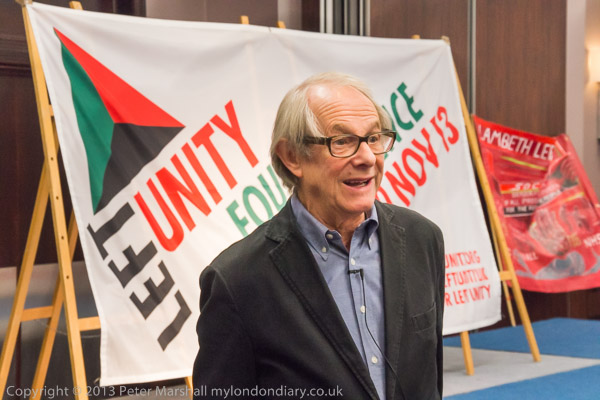 Ken
Loach is interviewed at the start of the conference
Ken
Loach is interviewed at the start of the conference
more pictures
People came from across the United Kingdom for the founding conference of Left Unity, a new radical left party brought together by an appeal by Ken Loach to defend the welfare state and present an economic alternative to austerity.
Around 500 people attended the founding conference at a hotel in Bloomsbury, London, spending the day discussing and voting on the proposed aims and constitution of the new party.
There were many differing views and a great many votes on them, with some constitutional tangles that both the chair and the members attending found confusing, but which were eventually resolved. While there was unanimity on many major issues, a number of votes were hotly contested, and counting the votes from the cards held up gave the tellers plenty of work during the sessions.
There was also a secret ballot over the exact name of the new party, and although there was strong support for some alternatives, 'Left Unity' emerged as the winner.
This was a meeting to found the party, and to set up a basis on which to develop, and unlike other party conferences there were no long conferences speeches, with everyone keeping to the business of the day, speaking for or against the various constitutional proposals and amendments. I think the longest speech allowed was five minutes, and that had to deal with a number of complex matters, and most speakers were limited to two minutes.
Despite the at times tedious nature of the proceedings and voting, spirits seemed to be high, with considerable optimism about the future for the party. Recent opinion polls have shown a great deal of public support for some left-wing policies and the country seems to both want and need a real alternative to the current parties.
The left has always failed to gain support (and not just here in the UK) because of factional differences and splits, and it remains to be seen if 'Left Unity' can continue to unite the different groups. At the moment there seems to be considerable goodwill.
But even if Left Unity holds, it still faces the huge uphill task that our
first past the post electoral system produces, and which has prevented the
Green Party from making the breakthrough here that it has in some other European
countries.
more pictures
Cyclists 'Die in' at TfL HQ
Blackfriars Rd, London. Fri 29 Nov 2013
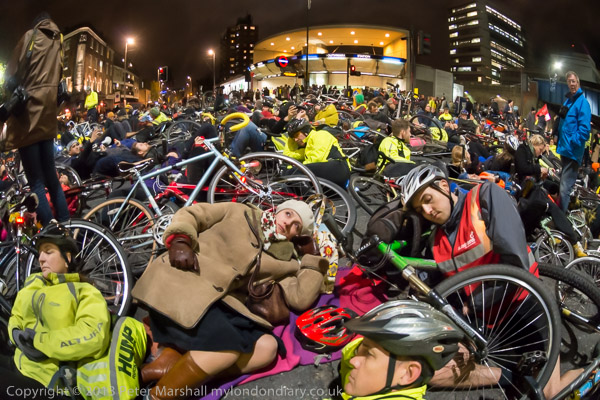
Over a thousand cylists and bikes filled the road in
a 'die-in' outside the TfL offices
more pictures
More than a thousand cyclists came to the protest outside the London HQ of TfL to protest at the lack of safe road provision that leads to many deaths of cyclists and pedestrians, holding a vigil, rally and a 15 minute 'die-in' on Blackfriars Road.
The protest was called after 14 cyclists were killed this year on roads in London, and many more injuries, and in particular after 6 recent deaths in two weeks, with another more recently. Cyclists want proper provision for cyclists and pedestrians on our roads, and an end to a policy that is almost entirely based on increasing the flow of motorised vehicles, with other considerations being largely ignored.
Even where TfL has provided cycle 'superhighways', these have been badly designed at many junctions, and marked cycle paths are used as parking places. The event organisers make the point that TfL have failed to make our streets safe for cycling and have listed their demands:
- We need Amsterdam levels of money spent on London's Cycling Safety NOW.
- Cycling Organisations need at least 2 formal Board Members on TfL Board.
- We need ALL Boroughs to be spending at least 10% of their Mayoral approved transport budgets spent on cycling infrastructure.
- We need all Borough and TfL Transport Heads qualified to deliver Dutch Style safety or be fired.
- Children, pensioners and inexperienced adults should not be forced to share space with HGVs and Buses.
- We need a FULL Integrated safely designed segregated cycle network in London ASAP.
- ALL dangerous junctions need to be redesigned to Dutch standards ASAP.
- Ban on any vehicles whose drivers cannot see adjacent road-users
At the protest they made clear that they don't intend to be attacking other road users stating that the changes they want would be to the benefit of all road users. Encouraging cycling as a means of transport - as can be seen in Holland and elsewhere - cuts down other traffic at key times and also cuts pollution and increases the health of the population.
Few of the deaths and serious injuries can be blamed on cyclists or on cyclists failing to wear helmets. Helmet use has little if any impact on cycle safety, and may actually make cycling more dangerous, and helmets are seldom if ever effective in serious accidents. And although some cyclists break the law - for example by jumping red lights - this is only a factor in 6%, less than 1 in 16 serious accidents. Cyclists see much of the current clamour in the media and elsewhere suggesting compulsory helmet use, licensing for cyclists and tougher enforecment penalties for riding without lights, on pavements and through red lights as simply trying to put the blame on the victims of road accidents rather than trying to make the roads safe.
Police had taped off the pavement area surrounding the Transport for London offices opposite Southwark Underground Station, and as cyclists arrived for the protest, Blackfriars Road was closed and was soon filled with people standing with their bicycles.
The protest began with a performance of an Eastern European song and a short introduction by organiser Donnachadh McCarthy to remind us we were here to remember the cyclists killed and injured on our roads as well as to agitate for safe roads. The cyclists then stood in silent vigil for around half an hour, while a cellist played solemn music, and those who had brought candles came and lit them around a bicycle.
We were reminded of the example of Amsterdam, where protests calling on the city to provide safe cycle facilities many years ago had led to the current high level of provision and use, with the bicycle becoming one of the major means of transport in the city. The Dutch had prompted the city into action by a series of 'die-ins' in the 1970s outside the city's offices, much like the one which was happening tonight outside the HQ of Transport for London.
The die-in then began, with the wide street full of bicycles and people. The bikes and people certainly spread perhaps a couple of hundred yards along the Blackfriars Rd, as well as spilling a little into The Cut and rather more back along Union St, and quite a few cyclists around me simply could not find the room to either put down their bike or lie down.
One or two had come prepared with mats, but most simply lay on the cold tarmac for the 15 minutes of the die-in. The street was so packed that all of my pictures were taken from a relatively small area, and even moving a few feet meant some very delicate stepping around heads, bodies, frames and wheels. I found it rather annoying that one or two photographers were standing in the middle of the cyclists, getting in the way of others taking pictures.
Police on the spot told the organisers that they estimated there were over a thousand cyclists there with their bikes, though the organisers put the figure closure to two thousand. True to form the BBC reported it as 'hundreds'. They could equally have said 'dozens' - after all a thousand is only just over 83 dozen! But really they should send their reporters to a course on counting - or on stopping distorting the truth.
After everyone had got up, the rally began, again with some singing, and
then some speeches. The first speaker was a man who had been fortunate to
survive after being run over by a bus on Oxford St - doctors had judged his
condition to be terminal - but he had survivied. Next came another of the
event organisers, speaking with conviction about the situation and what was
needed. As I left shortly afterwards, the names of the cyclists killed on
the streets were being read out.
more pictures
Islamists Protest Angolas Ban on Muslims
Angolan Embassy, Dorset St, London. Fri 29 Nov 2013
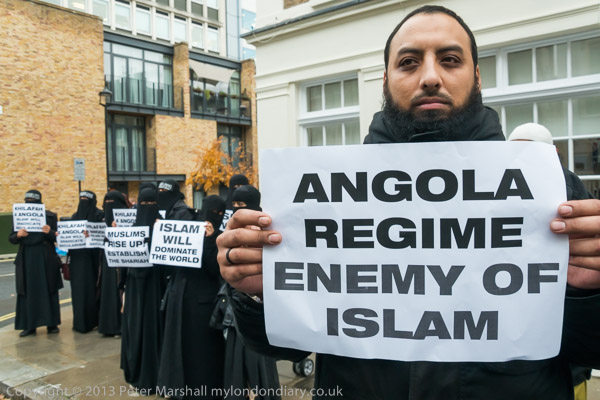
Protesters hold placards opposite the Angolan embassy
more pictures
Anjem Choudary and his supporters protested at the Angolan embassy against the ban on Islam there, the closing of mosques outside the capital, burning of the Koran and assualts on women wearing the veil.
There was no sign of the march announced by Anjem Choudary from the Regents Park Mosque after Friday prayers although I spent some time looking for it, but when I walked from there to the Angolan Embassy, I found a group of around forty of his supporters had arrived before me and begun to protest. I was told some fire-crackers had been let off before I arrived and that the people in the embassy had felt intimidated, but by the time I arrived the protesters were on the opposite side of the road, making speeches through a loud public address system and shouting slogans.
Half a dozen police arrived around 15 minutes later and talked to someone at the embassy door and the police also talked to one of the protesters who assured him that they would keep on the opposite side of the road and keep a clear path along the pavement. The police then stood back and watched the protest.
Around half an hour later Anjem Choudary arrived and made a speech to the protesters and to the embassy. Much of what he said about mosques in Angola being closed, about the forced destruction of some mosques and the intimidation of Muslim women wearing the veil has been confirmed by human rights activists in Angola.
The application by the Islamic Community of Angola (ICA) for legal recognition as a religious organisation was one of many rejected by the Angolan Justice Ministry last month. According to a report in The Guardian, there are only 83 approved religious organisations in Angola, every one of them Christian, and a statment from the Angolan embassy in the US claimed that they had 'lots of religions', citing "Catholic, Protestants, Baptists, Muslims and evangelical people." In other words, freedom of religion - so long as it is Christian.
But the protesters do not appear to want religious freedom either, but called for a ban on democracy and the establishment of a Islamic Khilafah (caliphate) in Angola, establishing Sharia law. 'Islam', stated one of the posters some held, 'Will Dominate the World'.
And while they describe the religious intolerance of the regime led by Angolan
president, José Eduardo dos Santos as a Christian crusade against Islam
it is rather against all minority religions as well as the estimated 90,000
Muslims, and is more about the regime's almost total lack of regard for human
rights. As Choudary himself pointed out, it is certainly not a Christian policy
- nor in any meaningful sense are other Western governments Christian, but
almost entirely secular. And as another of the posters says, ' Islam will
eradicate Secularism'. While almost all of us - whether Christian or Muslim
- would condemn the actions of the Angolan regime, I think few would feel
that an Islamist Khilafah would be any more likely to promote freedom of religion.
more pictures
Cultural Workers against Zero Hours
Millennium Bridge, London. Tue 26 Nov 2013
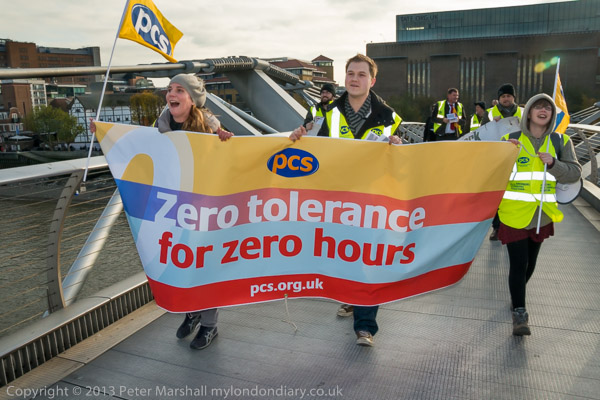
The 'Zero tolerance for zero hours' banner is carried
to the centre of the Millenium Bridge
more pictures
PCS members from national cultural institutions in London staged a protest at Tate Modern and on the Millennium Bridge against zero hour contracts which give them no guaranteed weekly hours or income, while stopping them taking on other work.
Employers use zero-hour contracts to cut wages, avoid holiday pay, pensions, and ensure the maximum flexibility and profit for themselves. Workers are also unable to take on other part-time work, as they are obliged to be available for work at the whim of the employer.
Among London's major cultural institutions using zero hour contracts are the Victoria and Albert Museum, English Heritage, the British Museum and the Tate. The use of zero hours contracts has doubled in the last five years and they are now used by over a quarter of British businesses for some of their workers - and for a total of around 5 million workers.
Zero hours contracts were initially designed for use in very limited and specific circumstances where there use might be justified but are now a widespread form of exploitation. The PCS (and other unions) "believe that guaranteed hours, a living wage, holiday and sick pay, respect for employment rights, and dignity and respect at work should be fundamental entitlements for all workers."
The protest was a part of a PCS young workers' week, and the group taking
part met with flags and banners outside Tate Modern, handing out leaflets
there before moving on to the Millennium Bridge. There they hung their banners
on the side of the bridge and explained their case using a megaphone, while
others handed out flyers. After around an hour they walked into the middle
of the bridge and tied the banners on its side, continuing to leaflet and
protest for another quarter of an hour.
more pictures
4:1 legal minimum NHS staffing
Dept of Health, Whitehall, London. Tue 26 Nov 2013
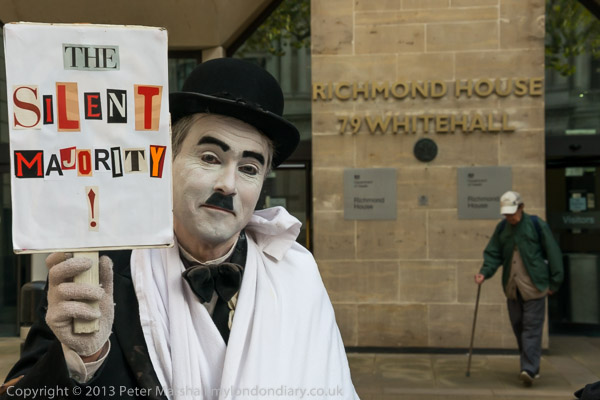
A Chaplin figure in a sling holds a placard 'The Silent
Majority' outside the Dept of Health
more pictures
Nurses in the 4:1 campaign protested at the Dept of Health for a manadatory staffing level of one nurse for every 4 patients in the NHS. They were joined by other groups protesting against closures and privatisation in the NHS.
The "Rally for the NHS" is described on Facebook as a response to "disastrous news about the NHS" in recent weeks, "from the RCN (Royal College of Nursing) revealing the NHS has over 20,000 nursing vacancies, to the Department of Health’s decision to downgrade (effectively close) 100 A&E departments."
The 4:1 campaign is a grassroots campaign started by nurses to raise awareness of the need of mandatory minimum nurse:patient staffing ratios in NHS services. It beleives that nurse:patient rations "affect a tremendous amount of how we work, the care we give and the care patients receive."
They say "The public have had enough of overworked staff, unprecedented avoidable death rates and negative press about the NHS. The public and nurses alike know the value of the NHS, and want to see it perform to its best, providing the dignified care patients deserve."
Other protesters pointed out the threat to the NHS of the EU-US Trade Treaty,
which would open up the whole of the NHS to privatisation and urged everyone
to sign a petition to urge that the NHS be exempted from this treaty. Also
present were those from several groups fighting to save hospitals, including
Lewisham and King George V in Redbridge, as well as others with more general
concerns, particularly over the Keogh report 'Transforming urgent and
emergency care services in England' and the planned closure of many A&E
units across the country.
more pictures
Justice Not Jumpers at NPower HQ
Bank, London. Tue 26 Nov 2013
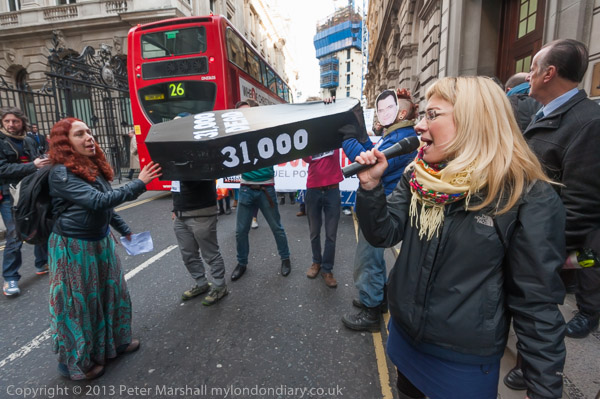
31,000 excess winter deaths states the coffin being
carried to nPower which made huge profits
more pictures
Fuel Poverty activists marched to the offices of NPower, one of the big six energy providers to protest against the profiteering by them that leads to people having to choose between eating and keeping warm, causing unnecessary deaths.
The protesters, including Fuel Poverty Action, UK Uncut, the Greater London Pensioners’ Association and Disabled People Against Cuts protested against the huge increase in energy costs and against the deception of the energy companies who blame price rises on 'green taxes'. The protest at NPower came on the day that new figures on last winter’s ‘excess winter deaths’ were due for release, and was one of several around the country, with protesters at British Gas's new Oxford HQ, as wel a s in Lewes and Bristol. Supporting groups include No Dash for Gas, Campaign Against Climate Change, Climate Revolution, Young Friends of the Earth, Frack Off London, Power for the People, Barnet Alliance for Public Services, Lewes Against the Cuts, SOAS Energy & Climate Change Society and Southwest Against Nuclear.
Campaigners carried a coffin filled with energy bills to the NPower offices in Threadneedle St where they held a rally at which some of those hardest hit by fuel poverty spoke about their experiences.
The campaigners say:
As the Big Six energy companies hike up prices we are told the only answer is to put on a jumper, leaving millions of us to choose between heating and eating. While the energy companies spread the lie that ‘green taxes’ are to blame, we know that the real problem is the privatisation of our energy for profit and the skyrocketing cost of dirty fossil fuels.
They say that NPower is the UK's most complained about energy company with double the customer complaints of its nearest rival EDF and higher price rises than any of the other Big Six this year (9.3% electricity and 11.1%. It has defened seeking what many see as an excessive 5% profit margin and has also paid zero corporation tax for the past 3 years despite a 34% profit rise of £413million last winter when its price hikes are estimate to have pushed 300,000 people into fuel poverty.
In the figures for the previous year there were 24,000 'excess winter deaths' in the UK, at least 30% attributable to cold homes. The new figures announced today for last year came as a shock, with an increase of almost a third to 31,000.
This was the figure on the coffin and the placards at today's protest by several hundred people. The protesters met at Bank, the centre of the City of London. Four of the protesters put on masks to carry the coffin, including those of David Cameron and George Osborne, as well as jumpers with the logos of the major energy companies.
The march set off, with pensioners in the lead, followed by the coffin, going down Cornhill to Bishopsgate, then turning into Threadneedle St and finishing outside the offices of NPower, which were guarded by a row of police. The pall-bearers marched up to them and set the coffin down in front of the entrance, while the rest of the protesters stopped on the street with their banners for a rally.
One of the first speakers was Andy Greene of Disabled People Against Cuts, who spoke of the effects the energy price rises were having, causing great hardship to many disabled people. A speaker then read out many testimonies from individuals about how they were having to chose between heating and eating, already cold and dreading the coming winter.
In a press release, Sarah Price of UK Uncut insisted "People must be put before profit, and with creative direct action, we will stand with the elderly, the poor and vulnerable to fight for OUR power. Fuel Poverty must end."
According to Joseph Murphy of Disabled People Against Cuts, "Another harsh winter will mean more disabled people will find themselves isolated in their homes, unable to heat them, or cook properly. Many don't make it through."
Susan Jarrett of UK Uncut said: ‘The fact that people are dying
of fuel poverty as Npower and other energy companies rake in the money and
avoid tax is a scandal. This Government is not only unnecessarily cutting
our services in the name of austerity but are allowing these energy companies
to literally get away with murder which is why we are fighting back today.'
more pictures
Virginia Water
Virginia Water Lake, Surrey. Mon 25 Nov 2013
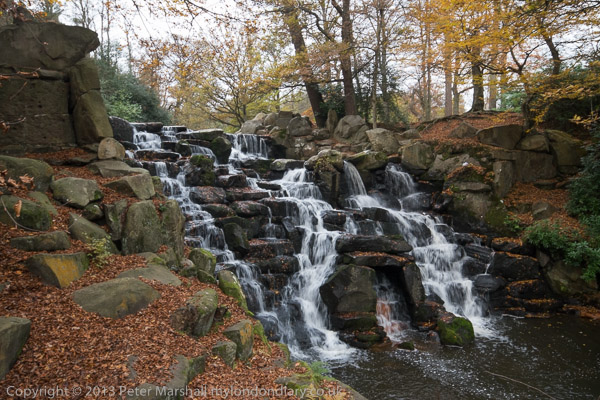
The waterfall where I used to climb on the rocks
more pictures
Some pictures from a short walk by the lake with family before a meal at the Wheatsheaf Pub. These pictures are not available for commercial use.
Virginia Water is owned by the Crown Estate, and is a part of Windsor Forest, once a truly vast stretch of country appropriated for private hunting after the Norman conquest (though only formally defined around 1240. Large parts of the area - the Lower Forest, Cranbourne Forest and South Forest - are still private areas, but other parts of 'Windsor Great Park' including that around the large ornamental lake dug at Virginia Water in the 1740s and greatly enlarged in 1780 are open to the public. Commercial photography however requires a licence, so these copyright images are not available for any commercial use.
I got my first two-wheeler on my sixth birthday and was able to ride it before the day was out. We didn't have 'stabilisers' in those days. You got on, you rode, at first with an adult hand on the saddle. You fell off a few times, and then you were free.
And for a kid back in the fifties, cycling was freedom. At first it was just around the local streets, and on to the heath, but by the time I was nine or ten I was riding much further afield, getting out of the London suburbs and out around Middlesex, Surrey and Berkshire (and in those days Bucks too.) Sometimes with a couple of mates, sometimes on my own, and on the longer journeys almost always on my own.
I think I first biked to Virginia Water when I was nine or perhaps ten, and it was just close enough that I could sometimes persuade my friends to cycle the eleven miles each way too. We took the shortest route, along the A30, then probably rather busier than it is today when the motorways have taken much of its traffic. Then everthing going to the southwest struggled through Staines High St and over Staines Bridge and then up Egham Hill, and we went with it, locking our bikes outside the gate by the Wheatsheaf and running inside to a wilderness of rhododendrons, where we untrramelled by political correctness would play at being savages or Cowboys and Indians.
The waterfall with its rocks was great to climb on, and we would cautiously make our way down and crouch in the small cave overlooking a deep pool. The cave was described in Taylor and son's 1868 guide as "a fit resting-place for the nymph of the stream in twilight hours". On hot summer days we would take off sandals and socks and dangle our feet in the cold water, and sometimes rather more.
Things are different now. Parents who gave their children the freedom everyone then took for granted would now be prosecuted and the kids taken into care. Parents and children alike are scared of strangers (he actual dangers are probably no more now than when I was young, and people were aware of them then but didn't over-dramatise.) Cycling was probably about as dangerous too, but we were taught the Highway Code and how to ride. Again, publicity, particularly about helmet wearing, has increased perceived risk (and possibly actual risk) but provided little if any extra safety.
Virginia Water has changed too. There are far more people now walking there, and cycling is now allowed on the main path around the lake, which is now metalled. There is a new visitor centre (I can't recommend the coffee - the Wheatsheaf nearby serves a better cup and has beer.) Much of the undergrowth we used to play in seems to have been cleared, and there are now boards to tell you what you are looking at, and notices to tell you not to walk across the top of the waterfall or climb on the rocks. Actually there probably were notices telling you not to climb on them when I was ten, but we didn't let things like that bother us when they were so obvious an attraction.
THis time I didn't cycle there but was driven in a car. We sat in the visitor
centre, had the coffee, walked along the path, past the waterfall and along
to the ruins of Leptis Magna, stones brought from the ancient Roman city in
Libya to the British Museum in 1816 and erected as a picturesque ruin here
in King George IV's back garden ten years later (and moved again later after
getting vandalised when they let the public in after his death.) We couldn't
climb on those either, as they were surrounded by a temporary fence as they
are being renovated yet again. We walked around a bit, admiring the later
Autumn colour, with many leaves still on the trees, then went to the Wheatsheaf
for an enjoyable meal and, for me at least, a couple of pints of beer.
more pictures
End Drone Attacks in Pakistan
Downing St to US Embassy, London. Sat 23 Nov 2013

A man bangs on a coffin that was carried to the US embassy
in the protest against drone attacks
more pictures
Imran Khan's Pakistani PTI party (Movement for Justice) and Stop the War marched from Downing St to a rally outside the US Embassy demanding an end to drone attacks in Pakistan and elsewhere which are killing many innocent people.
The protest was organised by Pakistan Tehreek-e-Insaf and supported by Stop the War, and the protesters gathered at Downing St to start the march, holding a brief rally there. I met the shortly after the march to the US Embassy had started, on Pall Mall.
There were around 500 people on the march, mainly British Pakistanis, but with some other anti-drone protesters from Stop the War and other groups. Unusually for a march of this size, the protesters were walking on the pavement, and stopping at all of the crossing lights. This created some problems for other pedestrians and meant that the march was soon broken up into several small groups of protesters, as those at the front did not wait for the gaps made by the crossings to close up.
It was only as the march started to cross Piccadilly as it neared Hyde Park corner that the police took any part in controlling traffic and only past there on the relatively empty pavements of Park Lane that this really could be seen to be a march. This was I think the first march that the PTI had organised and London and it showed.
Eventually all the marchers reached the US Embassy and made its way past the camp of the People's Mojahedin of Iran with its hunger strikers to hold a rally.
It was a noisy event, and a combination of poor amplification and some very
enthusiastic protesters who preferred to keep up their chants against the
US drone attacks made listening to the speeches difficult unless you were
fairly close to the speakers. I listened to a couple of the speakers while
photographing the crowd and then left.
more pictures
Remember Ricky Bishop - Jail his Killers
Brixton Police Station, London. Sat 23 Nov 2013
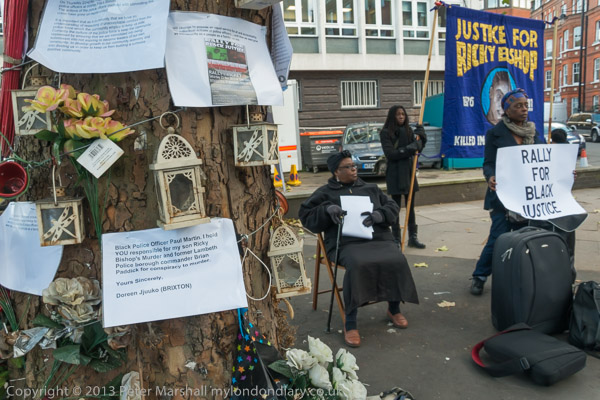
The remembrance tree outside Brixton Police station
with Ricky Bishop's mother, family members and banner
more pictures
At a rally outside Brixton Police Station where 12 years ago Ricky Bishop died after a violent assault by police, family members and campaigners called for the arrest, trial and convictions for murder of his killers whose names were read out.
On November 22, 2001, Ricky Bishop,a 25-year-old black man, was in a car being driven by a white friend in Brixton. The car was pulled over by police on Dalyell Rd as a part of the police 'Clean Sweep' operation. Bishop was searched, his pockets emptied and their contents put on the top of the car. At this point the police found no evidence of Bishop having any drugs, and they did not arrest him, but detained him and the car, handcuffing him and taking him to nearby Brixton Police Station. The white driver of the car was not searched or detained.
CCTV shows him arriving at the police station and being taken upstairs, but there was no CCTV record of what happened after he was taken upstairs to a small room.
Twelve officers were involved in what happened next, and their names are on a notice posted on the 'Remembrance Tree' outside Brixton police station, charging them with having murdered Bishop. Police claim to have found a chewed plastic wrapping of cocaine in his mouth during further investigation in that closed room, and attibute his death to that, but their own expert witnesses contradicted their story, suggesting that he would have had to take a 50 times larger amount while being held by police.
Bishop's sister says that while being restrained using illegal holds and methods by the police, Bishop, a healthy man who was also a fitness trainer, suffered a heart attack, and continued to be restrained, with medical assistance only given when it was too late to save him.
The police took him to A&E at King College Hospital, standing around his dead body and making jokes. By the time his mother was informed of his detention he was dead. The family say that police issued a misleading press release before informing the family of its contents.
It's difficult if not impossible to be entirely sure about what happened that day in Brixton Police Station, but what does seem clear is that the police reaction was to falsify evidence and to try and cover up what actually went on.
According to the press release by the event organisers, the International People’s Democratic Uhuru Movement (InPDUM), the police have admitted that illegal restraint was used, but Brixton police, then led by Brian Paddick (who was not one of the 12 officers involved), "covered up the brutal and violent assault by hiding evidence" including "handing in to the courts the wrong handcuffs used to contain Ricky on that day, sealing the wrong small room; and altering one of their own witness’s statement."
Certainly vital evidence appears to have been withheld at the inquest into Bishop's death, and the jury were only given the choice of three verdicts; death by misadventure, narrative, and an open verdict. They chose misadventure, exonerating the police and angering the family and supporters.
The protest today under the Remembrance Tree was the latest in a continuing
series of protests about this and other deaths at Brixton Police Station under
suspicious circumstances. Around 30 people came to show support for the Bishop
family and to call for the prosecution for murder of the 12 police officers,
whose names were being chanted as I left, each followed by a resounding chant
of 'Murderer!'. There were no police in evidence at the event, although
a police display van with the message 'Working for a Safer Lambeth'
was parked in front of the police station,just behind the banner showing Ricky
Bishop and calling for justice over what one of those speaking described as
a "modern-day lynching".
more pictures
Free Shaker Aamer March in Battersea
Northcote Rd, Battersea, London. Sat 23 Nov 2013
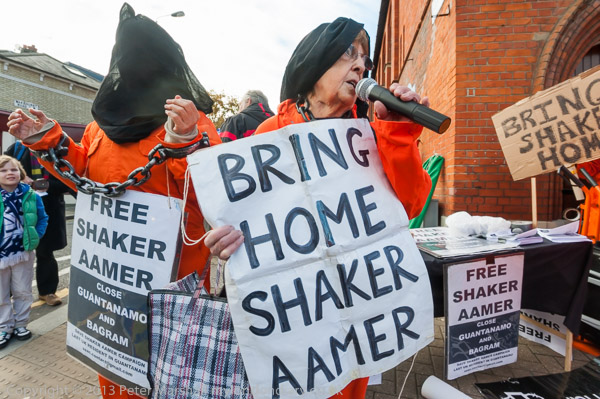
Joy Hurcombe Chair of the Save Shaker Aamer Campaign speaking before the march
on Northcote Rd
more pictures
A march and rally close to Shaker Aamer's Battersea home marked 12 years of detention and torture of this British resident charity worker kidnapped in Afghanistan and sold to US troops. Cleared for release in 2007, he is still in Guantanamo.
In June 2001, Shaker Aamer went from London with his family to work for a charity in Kabul. Four months later Kabul was bombed and he escaped out of the city with his family. Local bandits saw a chance to make money by kidnapping him and selling him to US forces on November 24, 2001.
He was then tortured in US custody in Bagram and Kandahar, at times in the presence of British intelligence agents, before being illegally rendered to Guantanamo Bay in February 2002. At Guantanamo he has been subjected to continuing daily abuse and torture even since having been cleared for release in 2007. He is regularly beaten by the guards and has been kept in solitary confinement for many months, in an absolute denial of his human rights.
Shaker Aamer has never been charged with any offence, never had any trial. Under both under both Bush and Obama administrations investigations at Guantanamo have cleared him for release, but despite this he remains in Guantanamo, the last British resident there.
The Save Shaker Aamer Campaign has been protesting and campaigning for his release over the years, and has attracted considerable support. Shaker's family live in Battersea, and the local Conservative MP, Jane Ellison, has supported his case along with a number of other MPs from both sides of the house. Both Labour and Coalition governments have urged the US to release him. His health has been deteriorating over the years, and there are currently fears that he is going blind. He should urgently be released and brought back to live with his family in London. He has never seen his youngest son, born after his capture.
The marchers met up outside the Baptist church on Northcote Rd, and handed out leaflets there and held a short rally for around half and hour before making their way along the busy street past the market and the shops close to Clapham Junction station before going up Lavender Hill to the Battersea Arts Centre for a longer afternoon rally.
Outside the church, holding a banner with the message 'I am waiting 12 years for Shaker Aamer', one of the protesters shouted loudly to passers-by "Shaker's a charity worker, lives round the corner. I know his wife & children. 12 yrs in Guantanamo!" and banners and placards called for his immediate release.
Among those who spoke before the march moved off were Joy Hurcombe,
the Chair of the Save Shaker Aamer Campaign and Dr David Nicholl,
a consultant neurologist and human rights campaigner from Birmingham who ran
the London Marathon in an orange jumpsuit in support of the campaign and also
went on hunger strike in sympathy with the many Guantanamo residents who took
part in a hunger strike this year. Local councillor Simon Hogg carried
one end of the main banner on the march, which attracted considerable attention
as it made is way along the busy streets with police stopping traffic to let
it pass.
more pictures
German Holiday
Neumünster etc. Nov 9-18, 2013
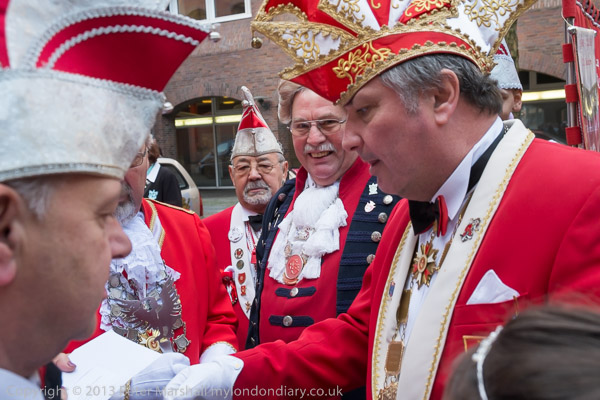
A carnival event which started at 11:11am on November
11 in Neumünster
more pictures
We spent 9 days in Germany, not exactly as tourists, but visiting friends, a family that my wife has known for well over fifty years since she began writing to a German penfriend at school in Hull, and the contact has continued several generations.
Neumünster where they live is in Schleswig-Holstein, right at the extreme north of Germany. We were there to celebrate the silver wedding of the eldest of her penfriend's three daughters. We were staying with her at Husberg, around 5km from the town centre, and went for some walks in the village and neighbouring Bönebüttel and the rural area around there. One afternoon we got on German bikes and cycled a few miles to the next settlement of any size to the east, Börnhöved. I didn't take photographs every day, but there are still quite a few.
Much of our time was spent with the family, and although I took photographs (and video at the main party) these are probably mainly of interest to those who were there. But we also spent some time during the week walking in the centre of Neumünster (it's twinned with Gravesend aong other places in Germany, Poland and Turkey), where I briefly photographed one of their carnival events on the 11th of November as well as many of its streets and buildings. We also visited the 'Designer Outlet' on the outskirts which apparently attracts shoppers from across north Germany, Denmark and even further afield. I didn't feel moved to buy anthing.
And we also too a trip to Kiel where I took a few pictures. Unfortunately
I didn't have a working camera with me when we went to Rendsburg and took
the bridge ferry over the Kiel Canal, but I still
enjoyed the trip and the food and ice-cream.
more pictures
Bonfire of Austerity Blocks Westminster Bridge
Westminster Bridge, London. Tue 5 Nov 2013
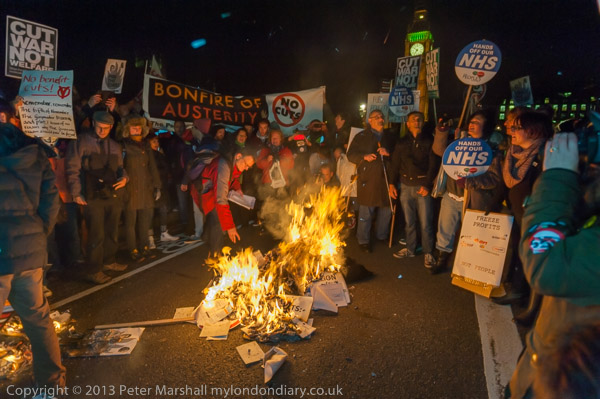
At the bonfire on Westminster Bridge
more pictures
The People's Assembly blocked Westminster Bridge on Bonfire Night as a part of their day of civil disobedience across the country, holding a rally where they lit a bonfire and burned energy bills.
Hundreds marched from Jubilee Gardens onto the road. blocking it as the evening rush hour was ending. The held a rally on the north bound carriageway in the centre of the bridge, posing for photographs before starting a bonfire on which they burnt energy bills.
Afterwards there were several speeches, including two fiery calls for justice from Owen Jones and Jeremy Corbyn MP, both scathing in their contempt of the actions of this and previous Tory governments. Recent polls have shown large majorities in the country in favour of the renationalisation of vital services, including the Post Office, Water, the Railways and Gas and Electricity. All of these sell-offs robbed the public of industries that were built on our taxes and have allowed wealthy individuals to make profits on the back of our long-term investments. There was a call for Labour Party to announce that the Post Office would be brought back into public ownership at the knock-down price for which it was recently sold.
The speeches had some competition from a nearby firework display as well as a young woman blowing large , and around half of those at the protest left at this point, as the police announced their intention of opening the south-bound carriageway. The protesters who remained decided to march on to join the 'Million Mask March' protesters who had now made their way to nearby Parliament Square.
I went with them and left around half an hour later, when Westminster Bridge was still completely closed to traffic. More police were being brought into the area around Parliament Square and it seemed likely that they intended to kettle the well over a thousand protesters still milling around the area.
Earlier in the day there had been other protests in London as a part of the
day of civil disobedience, including at Brent Magistrates Court, where Unite
Community Members, West London Peoples Assembly, Kilburn Unemployed Workers
Group, Brent Housing Action and the Zacchaeus Trust were protesting at the
12,000 summonses issued by Brent Council against those unable to pay their
council tax, mainly because of cuts in benefits, a protest against loan sharks
in Shepherds Bush and several events in Deptford against poverty. At the same
time as the central London protest, there was also a march and bonfire in
Lewisham against austerity, the bedroom tax and local cuts, finishing with
a 'Bonfire of Cuts' rally.
more pictures
Anonymous March on Parliament in London
Trafalgar Square, London. Tue 5 Nov 2013
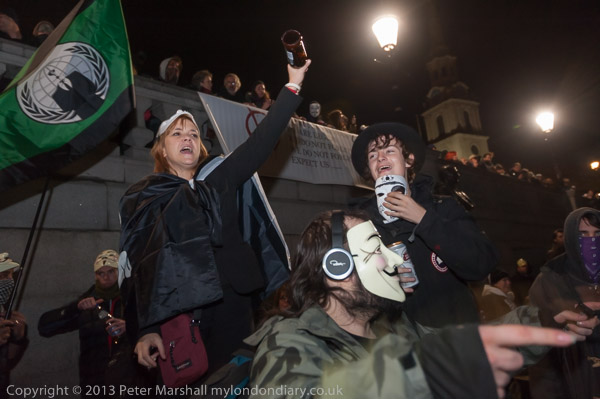
Anonymous flag and supporters in Trafalgar Square
more pictures
Around a thousand supporters of Anonymous met in Trafalgar Square before what was intended as a silent march to Parliament in continuation of last year's Bonfire night #OpVendetta. They intended to party in Parliament Square all night.
I photographed in Trafalgar Square and left shortly before the march began to go to another protest on Westminster Bridge. When that finished I walked with the protesters to join the Anonymous crowd in Parliament Square. There were a few people entertaining parts of the large crowd with music and a woman breathing fire but nothing much seemed to be happening.
I left a few minutes later as more police were moving in and starting to
stop protesters leaving. Later I heard that the protest had continued for
some hours, with some of the protesters making their way to Buckingham Palace,
where they fired a number of rockets into the front of the building.
more pictures
City Link & Cleaners at John Lewis
John Lewis, Oxford St, London. Sat 2 Nov 2013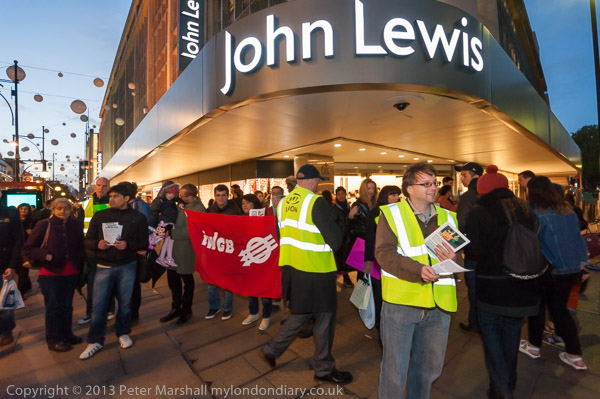
Cleaners from the IWGB and RMT City Link workers both
want John Lewis to live up to its principles
more pictures
City Link workers whose company was sold off to a private equity group and who face pay cuts, enforced overtime, loss of bonus scheme and other changes joined with John Lewis's cleaners in a protest outside the Oxford St store.
City Link deliver goods for John Lewis and their union, the RMT, has supported the workers who clean the store in their fight for better conditions and a living wage. City Link was previously owned by Rentokil Initial but earlier this year it was sold off to Jon Moulton's private equity group 'Better Capital.'
'Better Capital' is an example of the kind of private equity bankers and speculators responsible for our financial crisis, and 'Better Capital' is only better for the owners who profit from its activities. Certainly it isn't better for the City Link workers, with the company attempting to push through changes in their contracts that will make them much worse off.
The RMT say that "staff face pay cuts, enforced overtime, the axing of the bonus scheme and changes to travel arrangements that will leave them further out of pocket."
They say that the asscault on pay and conditions by the new owners has resulted in an surge of City Link workers joining the RMT to fight these cuts, and a number of RMT members were handing out leaflets outside the John Lewis's flagship store on Oxford St because John Lewis is one of the major customers for City Link.
They were joined there by members of the IWGB, the union for the cleaners at John Lewis who are fighting to get a living wage and better working conditions. All the other workers at John Lewis are directly employed by the company as 'partners' and share in the profits through a bonus scheme. Cleaners are paid a pittance - less than the amount needed to live on in London - and have unsocial hours and poor conditions of service. Among those taking part was one former John Lewis 'partner' who was sacked after giving an interview to The Guardian supporting the cleaners' cause; he is still waiting for an appeal over his sacking to be heard.
Most of the cleaners are from Latin America, and were late to arrive at John
Lewis as they were at an English class and were not yet ther by the time I
had to leave.
more pictures
LoNdOn ZoMbIE WaLk VII
Soho, London. Sat 2 Nov 2013
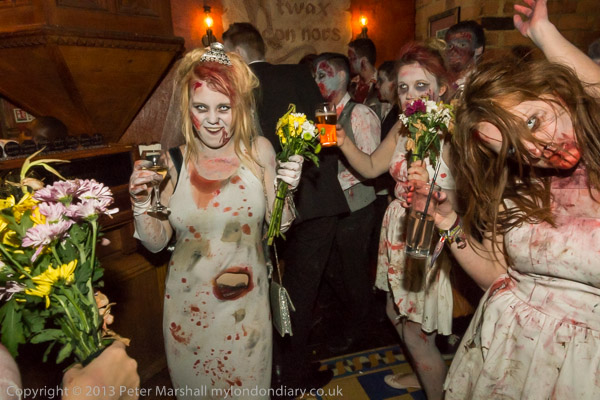
One of many pictures I took in the pub
more pictures
Around a hundred zombies met in Waxy O'Connor's pub on Rupert St, drinking there for a couple of hours occasionally emerging into the dim daylight of Wardour St for a fag break. Around 4pm as dusk was falling the multitude of undead staggered up the stairs to begin their crawl around Londinium in search of brains and booze. I left them to it.
Announced as the seventh consecutive year for this event, it followed on
from some earlier 'Crawls of the Dead' which began in 2004.
more pictures
Gurkha Veterans Hunger Strike for Justice
Downing St, London. Sat 2 Nov 2013
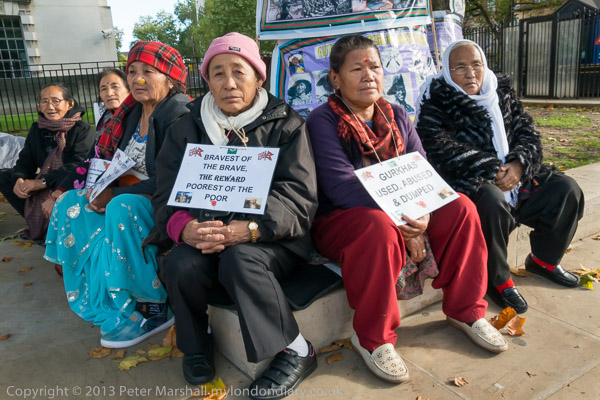
Gurkha wives and widows support the campaign for justice
more pictures
Elderly Gurkha veterans did not benefit from earlier campaigns for fair treatment and most live here in extreme poverty. Their petitions and protests for justice have been ignored and they have begun a series of hunger strikes.
The Ghurkas were protesting opposite Downing St, sitting on the low stone wall around the grass or on chairs underneath the statue of Montgomery, with a display giving details of their cause.
They submitted a petition to Prime Minister David Cameron and the Nepalese Prime Minister in April and getting no satisfactory result "with a heavy heart ... issued an ultimatum to Downing St that if serious action does not take place and talks are not held with our advocated by 24 October 2013" they will begin a programme of nonviolent resistance (Satyagraha) with hunger strikes, at first with a "13 days relay hunger strike in the name of the 13 Ghurka VCs followed by a fast-unto-death."
They are now on the first stage of the relay hunger strike for their five demands, equal pennsions, compensation, a preserved pension for those made redundant, the right of settlement in the UK for their adult children and free medical treatment in Nepal.
If they get now justice by 12pm on November 7th they intend to begin a hunger
strike unto death. (That fast to death began as planned, but after two weeks
the government offered talks and it was halted.)
more pictures
Free Kieron & Arctic 30
Russian Embassy, Notting Hill, London. Sat 2 Nov 2013
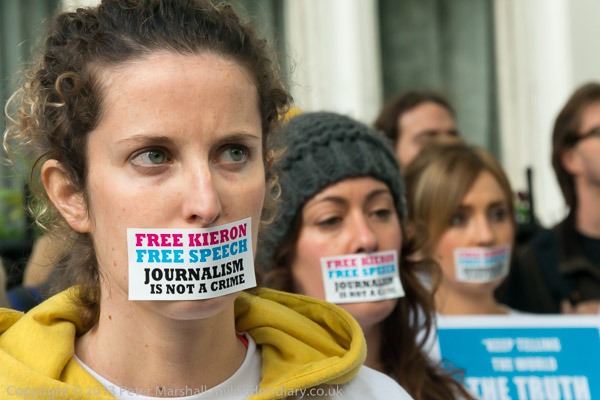
Protesters with their lips sealed 'Free Kieron Free
Speech -Journalism is not a crime'
more pictures
Family, friends & supporters of freelance videojournalist Kieron Bryan, one of the 30 arrested on Greenpeace's Arctic Sunrise, held a silent vigil at the Russian Embassy, delivering a petition signed by over 1000 journalists calling for his release.
The protesters wore labels sealing their lips with the message 'Free Kieron - Free Speech - Journalism is Not A Crime' as they stood facing part of the embassy across the busy Bayswater Road. There was intense media interest in the event, with several TV crews, radio journalists and photographers, perhaps because the imprisonment of a journalist is a threat to all journalists around the world. Most of the journalists present were among the more than a thousand who had already signed the petition for his release, and others added their names this morning.
Kieron's family, particularly his mother and father were interviewed about his condition in a Russian jail, where he is confined to his cell for 23 hours a day, either on his own or with a Russian speaking cell-mate - and he is slowly learning a little Russian.
His case, along with that of the other 29 detained is due to be reviewed shortly, but they could be kept for a very long time before actually coming to trial. The original charges were of piracy and although it has been reported that this will be replaced by one of hooliganism, it isn't entirely clear that this will be so, and they 30 may face both charges, with the lesser offence still having a maximum sentence of seven years. Although concentrating on Kieron, the protest organised by the Free Kieron Campaign also called for the release of the rest of the 'Arctic 30'.
But as the protest banners and placards made clear, Kieron was neither a pirate or a hooligan, but a working journalist. As he says "Keep telling the world the truth. I'm a journalist. I was doing my job, that is all." Journalist's organisations, including the NUJ have expressed their support for him. Another journalist, Russian freelance photographer Denis Sinyakov is also among those detained.
Kieron's brother Russell who has been a leader in the Free Kieron campaign
was one of the two allowed into the private road where the main building of
the Russian Embassy is situated, and where Russian officials had agreed to
talk with them.
more pictures
top of page
All pictures on this section of the site are Copyright © Peter Marshall 2013; to buy prints or for permission to reproduce pictures or to comment on this site, or for any other questions, contact me.

